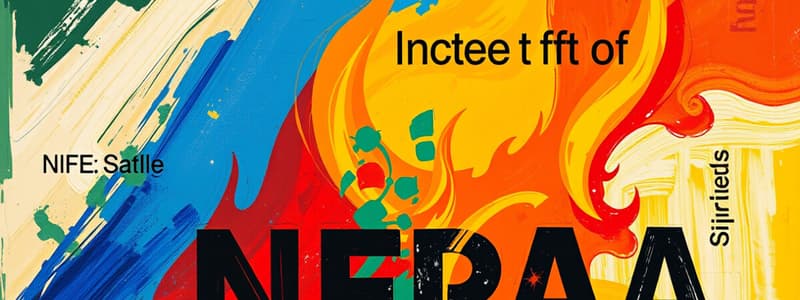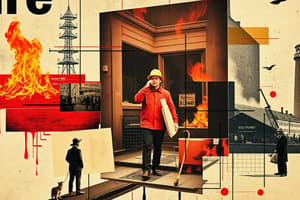Podcast
Questions and Answers
What does NFPA stand for?
What does NFPA stand for?
- National Fire Policy Association
- National Fire Protection Association (correct)
- National Fire Prevention Agency
- National Fire Preparedness Association
What is a flammable liquid?
What is a flammable liquid?
A liquid that has a flash point below 100 degrees F and a vapor pressure not exceeding 40 psia at 100 degrees F.
What is a combustible liquid?
What is a combustible liquid?
Liquid having a flash point at or above 100°F (37.8°C) and below 200°F (93.3°C).
What is Class I?
What is Class I?
Define Class IA Flammable Liquid.
Define Class IA Flammable Liquid.
Define Class IB Flammable Liquid.
Define Class IB Flammable Liquid.
Class IC flammable liquids have a flash point ______ and _______.
Class IC flammable liquids have a flash point ______ and _______.
Class II combustible liquids have a flash point ______ and _______.
Class II combustible liquids have a flash point ______ and _______.
What is the flash point for Class IIIA combustible liquids?
What is the flash point for Class IIIA combustible liquids?
Class IIIB combustible liquids have a flash point _______.
Class IIIB combustible liquids have a flash point _______.
What is a flash point?
What is a flash point?
Define vapor pressure.
Define vapor pressure.
What does equilibrium refer to in chemistry?
What does equilibrium refer to in chemistry?
What is the fire point?
What is the fire point?
What is usually the relationship between flash point and fire point?
What is usually the relationship between flash point and fire point?
What is the lower flammable limit?
What is the lower flammable limit?
What is the upper flammable limit?
What is the upper flammable limit?
Define autoignition temperature.
Define autoignition temperature.
What does specific gravity measure?
What does specific gravity measure?
Define vapor density.
Define vapor density.
What is evaporation rate?
What is evaporation rate?
What does water solubility refer to in the context of flammable liquids?
What does water solubility refer to in the context of flammable liquids?
Define boiling point of a liquid.
Define boiling point of a liquid.
What is a Boiling Liquid-Expanding Vapor Explosion (BLEVE)?
What is a Boiling Liquid-Expanding Vapor Explosion (BLEVE)?
What characterizes a flammable gas?
What characterizes a flammable gas?
What is the relationship between the volume occupied by gas and temperature and pressure?
What is the relationship between the volume occupied by gas and temperature and pressure?
What is carbon monoxide?
What is carbon monoxide?
What does CO2 stand for?
What does CO2 stand for?
Define hydrogen cyanide.
Define hydrogen cyanide.
Flashcards are hidden until you start studying
Study Notes
Fire Protection Basics
- NFPA: National Fire Protection Association, a key organization for fire safety standards.
- Flammable Liquid: Flash point below 100°F and vapor pressure not exceeding 40 psia at 100°F.
- Combustible Liquid: Flash point at or above 100°F and below 200°F (37.8°C - 93.3°C).
Classification of Liquids
- Class I Liquids: Flashpoint less than 100°F.
- Class IA Flammable Liquid: Flashpoint below 73°F; boiling point below 100°F.
- Class IB Flammable Liquid: Flashpoint below 73°F; boiling point at or above 100°F.
- Class IC Flammable Liquid: Flashpoint greater than or equal to 73°F and below 100°F.
- Class II Combustible Liquids: Flashpoint greater than or equal to 100°F and below 140°F.
- Class IIIA Combustible Liquids: Flashpoint at or above 140°F and below 200°F.
- Class IIIB Combustible Liquids: Flashpoint greater than or equal to 200°F.
Fire Behavior and Characteristics
- Flash Point: Lowest temperature a liquid generates sufficient vapor for combustion.
- Fire Point: Temperature where material continues to burn; typically a few degrees higher than flash point.
- Lower Flammable Limit (LFL): Minimum vapor concentration for combustion; increases in temperature/pressure lower LFL.
- Upper Flammable Limit (UFL): Maximum vapor concentration for combustion; increases in temperature/pressure raise UFL.
- Autoignition Temperature: Lowest temperature causing combustion without an ignition source.
Physical Properties of Liquids
- Specific Gravity: Weight of a mineral compared to equal volume of water; values less than 1 indicate lighter than water.
- Vapor Density: Weight of vapor compared to equal volume of air; vapors from flammable liquids are typically heavier than air.
- Evaporation Rate: How rapidly a liquid converts to vapor at given conditions.
- Water Solubility: Some flammable liquids like alcohols dissolve in water, reducing flammability and static hazards.
Temperature and Pressure Dynamics
- Boiling Point: Temperature a liquid turns into vapor; decreases under lower pressure.
- BLEVE: Boiling Liquid-Expanding Vapor Explosion occurs when a container fails at atmospheric pressure while holding liquid above boiling temperature.
- Gas Behavior: Volume occupied by gas is directly proportional to temperature and inversely proportional to pressure.
Toxic Gases
- Carbon Monoxide (CO): Odorless, highly poisonous gas from incomplete combustion; 210 times more reactive with blood than oxygen.
- Carbon Dioxide (CO2): Commonly produced gas during combustion.
- Hydrogen Cyanide: Highly toxic gas produced from burning certain materials.
Studying That Suits You
Use AI to generate personalized quizzes and flashcards to suit your learning preferences.




